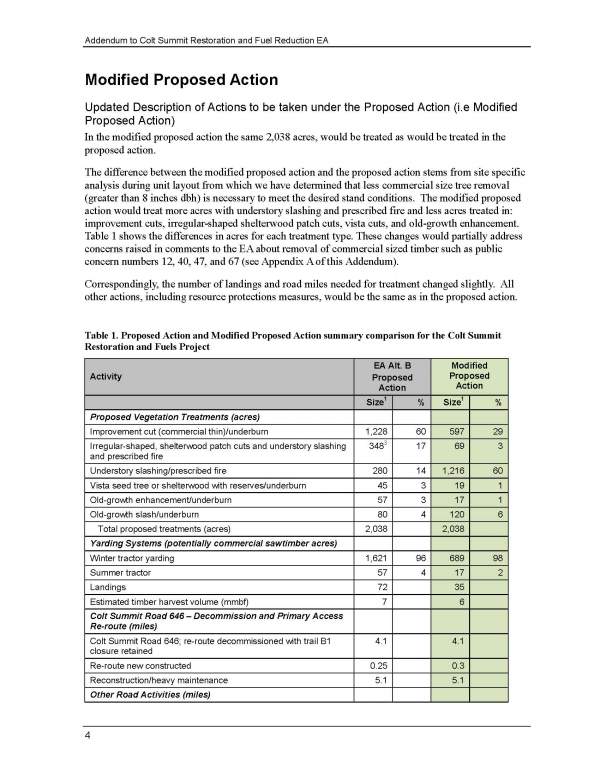I think it would be interesting to investigate further exactly what the FS did right with the cumulative effects of other species, and apparently, according to Judge Molloy, did wrong with lynx.
It seems odd to me that the FS would do an adequate analysis for the other species, but not for lynx (look at past, present and reasonably foreseeable future actions). Below is a quote from Judge Molloy’s decision (italics in both below quotes are mine) :
Once an agency detemines the geographical scope of its cumulative-effects
analysis, it must analyze the incremental impact of the proposed project when
added to past, present, and reasonably foreseeable actions within the selected
geographical area. Ctr for Envtl. Law & Policy, 655 F.3d at 1007; 40 C.F.R. §
1508.7. The plaintiffs in this case insist the Forest Service’s cumulative effects
Cumulative effects on lynx analysis for lynx is inadequate. On this point they are correct. On remand the
Forest Service must prepare a supplemental EA that adequately addresses the
cumulative effects for lynx, and if necessary after that review, an EIS.
“Consideration of cumulative impacts requires some quantified or detailed
information that results in a useful analysis, even when the agency is preparing an
EA and not an BIS.” Id. “An EA’s analysis of cumulative impacts ‘must give a
sufficiently detailed catalogue of past, present, and future projects, and provide
adequate analysis about how these projects, and differences between the projects,
are thought to have impacted the environment.'” Te-Moak Tribe ofW. Shoshone of
Nev. v. U.S. Dept. ofInt., 608 F.3d 592, 603 (9th Cir. 2010) (quoting Lands
Council v. Powell, 395 F.3d 1019, 1028 (9th Cir. 2004)). “An agency may,
however, characterize the cumulative effects ofpast actions in the aggregate
without enumerating every past project that has affected an area.” Ctr for Envtl.
Law & Policy, 655 F.3d at 1007.
When there is no BIS containing a cumulative effects analysis, “[T]he scope
of the required analysis in the EA is correspondingly increased.” Kern, 284 F.3d at
1077. “Without such information, neither the court nor the public … can be
assured that the [agency] provided the hard look that it is required to provide.” Te
Moak Tribe ofW Shoshone ofNev. , 608 F.3d at 603 (citations and internal
Depending on what the cumulative effects analysis
shows, the Forest Service might be required to prepare an EIS for the Project. See
40 C.F.R. § 1508.27(b)(7).
Here, the Forest Service did not discuss or mention any past projects oractions in its cumulative effects analysis for lynx. (See EA, A-I FS000066.) In the
EA, the Forest Service discusses how it recently acquired 640 acres ofland owned
by Plum Creek Timber Company. (fd.) It discusses the impact of snowmobile
activity in the area. (Id.) But there is no discussion of past projects or activities.
Even assuming there are no past projects or activities that would have a
cumulative effect when considered along with the Colt Summit Project, the Forest
Service must still “characterize the cumulative effects of past actions in the
aggregate.”
“neither the court nor the public … can be assured that the [agency] provided the
hard look that it is required to provide.” Te-Moak Tribe ofW. Shoshone ofNev. ,
608 F.3d at 603 (citations and internal quotation marks omitted).
etr for Envtl. Law & Policy, 655 F.3d at 1007.
I thought it would be interesting to compare the Judge’s statements to the US Attorneys’ on the point of cumulative effects on lynx, but don’t have a PACER account, nor would I know exactly what document to look for. To me, it would be illuminating to hear both sides. Can someone help locate this document, so we can hear the other side?
I could easily find the appeal response here (worth looking at to examine the kitchen-sinkery that the plaintiffs started with during the appeal).
Issue 32. The appellants allege the significance of the cumulative effects of habitat
fragmentation and reduction due to logging, road building, fire suppression, and other
management activities in regards to their effects on population levels or viability was not
disclosed.
Response: The Wildlife Report (PF, Doc. A-20, Table 5, pp. 14 to 15) indicates the project may
impact some individuals of some species, but there is no indication of project effects on
population levels or species viability of any threatened, sensitive, or management indicator
species.
Fragmentation is discussed in the Wildlife Report (PF, Doc. A-20, pp. 93 to 96). It concludes
that the proposed action would have “no impact” on fragmentation, corridors, or linkages
because the vegetation would not be altered beyond patterns that occur naturally from fire and
other disturbance, and open road density would not increase.
Cumulative effects discussions are covered in the Wildlife Report’s affected environment
sections (PF, Doc. A-20). Effects for connectivity, fragmentation, and linkages are discussed
where that issue has been raised: lynx (pp. 27 to 31); grizzly bear (pp. 35 to 45), fisher (pp. 49 to
52), wolverine (pp. 53 to 54), northern bog lemming (pp. 55 to 56), Townsend’s big-eared bat
(pp. 57 to 58), black-backed woodpecker (pp. 60 to 65), flammulated owl (pp. 67 to 70), boreal
(western) toad (pp. 70 to 72), northern goshawk (pp. 76 to 81), elk (pp. 81 to 85), and pileated
woodpecker (pp. 87 to 91).
The Biological Assessment for lynx and grizzly bear (PF, Doc. A-25) and subsequent letters of
concurrence (PF, Doc. K-14) indicate the USFWS concurred with the determinations for these
species (which include analyses on linkage and corridors). The record discusses effects of
habitat fragmentation on population levels and viability and is in compliance with NEPA,
NFMA, and ESA.
